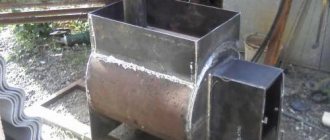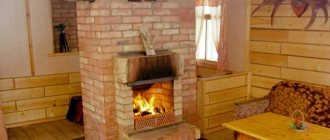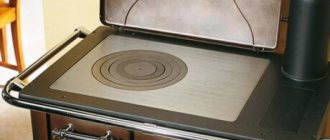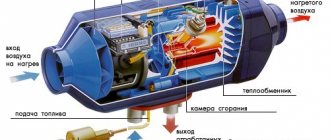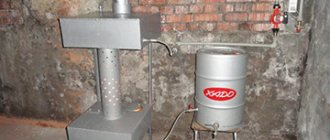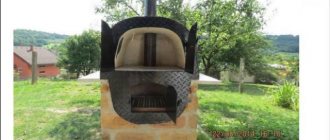The design features of a modern furnace are constantly being modified and improved, new elements are replacing old ones. But a number of functional details remain unchanged attributes and it is simply unrealistic to do without them . These include grates for ovens. This combustion element of a potbelly stove or fireplace, supporting firewood, coal and fuel briquettes, provides good traction . Through the holes, ash falls down, which makes room for a new fuel load. Cast iron grates of modern stoves can have different designs and are made of various materials, including metal corners .
Types of grate
Material
The temperature in the furnace is quite high, which forces craftsmen to make grates from special metals:
- The most durable is a cast iron oven grate.
- There are also steel parts, the most popular of which is antipyretic steel. Such grates are not susceptible to oxidation and corrosion when the flame burns, and also do not deform. These devices can have different sizes and shapes, the abundance of which makes it possible to choose a grate even for a non-standard stove model.
Example of a grate for a furnace
Solid and stacked
For convenient use, you can choose different grate designs:
- Solid. They look like monolithic gratings; they cannot be broken down into smaller components. Most manufacturers have standard oven grate sizes, focused on the most popular oven models. The choice of sizes of solid parts is quite large. Preference should be given to a certain product taking into account the fuel surface area.
- Stacked grates. They have a collapsible shape and can be assembled independently. The number of their components depends on the required area of the device. This guarantees their versatility, because the oven grate can be made in any size and is suitable for non-standard ovens.
Fixed
Fixed devices are grilles that do not move.
Subtypes of fixed grate:
- tiled flat, the most popular;
- basket, rarely used;
- beam
Tiled - these are rectangular-shaped parts and are the most popular. They can be used for any model, they are universal and easy to install. The stores offer a huge selection of grates of this particular type.
Basket grates are not very popular, because they are used for open ovens. In the old days, they were components of ovens on which food was cooked. Nowadays gas and electric stoves are used for this.
Beam gratings visually resemble a construction beam. They are assembled only by hand. Consumers like them for their versatility and the ability to install them in any oven.
Movable
Subtypes of movable grate:
- full-rotary;
- swinging;
- chain
Movable furnace grates consist of several parts. These include sections and shaft. Thanks to the possibility of rotation, the process of cleaning ash is simplified. Movable gratings are divided into full-rotating and swinging: the angle of inclination of the first is 180 degrees, the second can rotate from 30 degrees. Another type of such gratings is chain. In its design, the elements are connected to each other by chains. The disadvantage of this type of grate is the incomplete combustion of wood or coal.
Initial information
Self-made structures made of steel, when compared with their brick counterparts, are distinguished by the speed of construction and increased heat transfer. To carry out the work, it is enough to find a pipe whose diameter will be approximately 50 centimeters. Such products are especially relevant for small objects.
Approximately the following pipe needs to be prepared.
- The heating structure must be located in a place where reliable fire protection is provided for materials that are easily ignited.
- The area occupied by this facility should not exceed 0.15 percent of the usable square footage of the heated room, since it is not very comfortable to carry out water procedures in a cramped environment.
- The side surfaces of the structure must be covered with heat-insulating materials so that the risk of burns is minimized.
- When installing, you should take care of the correct location of the stove, because the heat emanating from it should spread in different directions, thereby ensuring high-quality heating.
Basic elements
Any of the fragments listed below performs some function, so it is important to study all the details in full
The structure of a sauna stove with water supply.
- The firebox is the main chamber where organic fuel is usually burned to heat the walls and then the surrounding air.
- The ash pit is located below the previous chamber, ensuring the collection of ash, which is formed as a result of the combustion of organic substances.
- The stone container allows you to lay cobblestones of jadeite, gabbro-diabase, crimson quartzite or other high-temperature resistant analogues.
- The pipe is a hollow product that is necessary to remove combustion products from the main chamber.
- The grate is an element inside the firebox that makes it possible to hold a layer of solid substance intended to produce thermal energy.
- Blower and firebox doors allow you to control the flame by covering it, which leads to a decrease or increase in oxygen inside.
- A pipe valve is usually made in the form of a control element that moves perpendicular to the working medium.
Shown is a homemade grate made from rebar.
Dimensions
Another condition for choosing a grate for a stove is its length and width. The sizes of the grate for the furnace are different, they are determined by the type of fuel:
- For light firewood or briquettes, grates from 140x120 mm to 330x252 mm are sufficient.
- For coal, larger parameters are needed: 300x300, 350x300, since this fuel emits a large amount of harmful substances when burned.
Variety of grate sizes
Ways to solve the problem
If the grate is damaged, there are two options: fill the ash chamber with a brick or install a new grate.
The option of filling is acceptable only if the integrity is damaged or there are cracks and it is impossible to eliminate them at the base of the ash pit. At the same time, it would be good to replace the firebox door from a blank door to a door with a grille to regulate the flow of secondary air. But this option will definitely create a lot of unnecessary trouble and reduce the efficiency of the furnace. Therefore, we change the grate.
The grate is usually made of cast iron. Cast iron is very different from brick in terms of CTE - coefficient of thermal expansion. This indicator for iron is much higher than for ceramics. Therefore, the grate is always placed freely with a gap of 5-10 mm around the entire perimeter. Some manuals recommend filling the gaps between the masonry and the grate with sand. But this is very stupid advice. Unnecessary and even harmful. Firstly, the sand from the heat of the coals (and it can reach 1100 degrees Celsius) simply sinteres - vitrifies, tightly welding the grate to the masonry and depriving it of the necessary freedom. Secondly, after the first fire, this gap is filled with ash - a non-flammable and non-caking material. So why make unnecessary movements?
The figure shows the correct (bottom) and incorrect (top) position of the grate
Usually the grate is placed in a brick trough or in grooves selected in the brick. If the integrity of these grooves is damaged and it is impossible to restore them, you will have to come up with some kind of supports. Sometimes they try to get out of the situation by driving nails, metal plates, etc. into the seams of the masonry. All this is in vain - the metal is quickly tempered and ceases to hold the grate, and more massive pieces of iron are unacceptable - they will tear the masonry.
Buying tips
For high-quality combustion, not only the size of the grate is important, but also the weight of the fuel that it can withstand in one laying. The rods should not deform or wear out.
The grate must have a sufficient number of holes - at least 40% of the area of the part itself. If this figure is lower, then there will not be enough oxygen to maintain the fire, and the ash will remain on the grate and clog the stove.
If the gaps in the grate have a large area, then the remaining fuel will fall from the combustion chamber into the ash pan. Fuel consumption will become uneconomical.
Optimal lattice option
Why is it needed?
As has already become clear, the grate is a grate that allows the air flow to penetrate directly to the combustion center below, and the ash to be removed through the holes to a specially designated place for it. So why do we need grates in a furnace? Installing a grate in a furnace allows you to solve a number of problems:
- Divides the combustion chamber into two zones - the combustion chamber itself and a niche for ash.
- Used for placing and drying fuel.
- Distributes the air flow from the ash pan.
- Promotes good traction.
- Together with the door it makes it possible to control and regulate the flame.
The grate, which is intended for installation in the stove, cannot be made from any metal. Since it is constantly exposed to high temperatures and oxygen, it can begin to oxidize very quickly. Only cast iron can survive in this environment for a long time
What is needed for production?
It is possible to make a grate with your own hands. What to make a grate for the oven from? It is better to use heat-resistant steel as a material, because it is impossible to work with cast iron at home. To make the grille, you can use any materials that have heat-resistant characteristics. This could be fittings, corners, steel pipes or strips of metal.
To make grate bars you will need:
- the metal from which the grille will be made,
- steel rods for creating partitions;
- ruler, tool for making marks;
- grinder for cutting material;
- welding.
How to make grate bars for a stove with your own hands?
From reinforcement
It is not difficult to make a grate from reinforcement yourself. It is enough to select the desired length of the product and cut the reinforcement with a grinder. It is necessary to determine the number of strips and take into account clearances for ventilation.
When the required amount of material has been prepared, you can begin welding the grate using rods. Do-it-yourself grate bars for the stove made from reinforcement can be seen in the photo below:
Video instruction:
From the corner
Making a grate for a stove with your own hands from a corner is even easier than from fittings. To do this, it is enough to weld two corners of the required sizes together: one side is equal to the width of the product, the other to the length. The result will be a rectangular base for the future part. The grate can be made from reinforcing bars or thick mesh.
Video instruction:
How to install grate bars in the oven with your own hands?
To install the grate in the furnace, it is not necessary to call a specialist. You can do this yourself, spending very little time and effort on this process.
Installing a grate in a brick kiln has its own characteristics:
- You need to understand that metal tends to expand. Therefore, you need to make gaps of at least half a centimeter along all edges of the product.
- The grate should be placed a little lower (about one brick) from the firebox door. This will prevent heat from escaping from the oven.
Stage 1
Stage 2
Stage 3 - Do not pack the grates too tightly into the oven. This can lead to deformation and cracks when the metal is heated.
- The gap between the grate and the stove is filled with sand. It is important not to use cement admixtures, because the part should not be held tightly.
Does it matter which side the grates are placed in the oven? Yes, when the grill bars have a triangular or any other protruding shape, the top should point down.
Examples of installation in a brick kiln:
Example 2
Example 3
Example 4
Example 5
Installation of grate
The grate is usually installed during the construction of the furnace. However, sometimes it is necessary to replace it in an already operating heating device or structure. In this case, it is necessary to understand for what reasons this unit was damaged or fell out of its seat.
An example of installing a grate in the combustion chamber of a brick kiln being built
When building a brick oven, the seat must exceed the dimensions of the grate by 5 mm on each side of its perimeter - this thermal gap will be an excellent protection against damage to the masonry and from deformation of the metal part itself when heated to high temperatures. As you know, all materials expand when heated, but the linear expansion coefficients of brick and metal differ quite significantly, and this requires a mandatory compensation gap.
As a rule, the bricks framing the nest for the grate are cut slightly at an angle, approximately as shown in the illustration above. This makes it easier to install and, if necessary, dismantle and replace the grille, and simplifies the process of cleaning it.
These gaps between the brick and the lattice are filled with dry sand or a mixture of sand and clay. But under no circumstances should cement-containing mortar be used. Sometimes an asbestos cord is laid along these cracks.
As a rule, the plane of the grate should be one row of masonry below the fire door - this prevents burning coals from falling out when the stove is opened. Naturally, this rule must also be observed in fireplaces with an open firebox - the lower edge of the hearth should be higher than the grate.
The grate also needs to be correctly placed in place, without mixing up the sides. Very often, the grate lintels have a triangular (trapezoidal) shape in cross-section. In this case, the pointed side should face towards the ash pan.
In conclusion, it is necessary to briefly summarize the information presented above:
The dimensions of the grates are most often subject to standards. When drawing up furnace designs, they usually start from these established dimensions. But if necessary, you can assemble a grate of a more complex or non-standard configuration using separate beam grates or small modules. The manufacturing material is selected depending on the selected fuel. But by far the best material for metal stove fittings, proven over many years of use, is cast iron.
But even among cast iron grates there are divisions into wood-burning or coal stoves. When installing the grate, it is important to properly prepare the seat in advance. It is easiest to install monolithic grate bars. But the stacked and beam options expand the possibilities, usually last longer, and their maintainability is much better
It is easier to replace one, for example, cracked grate, than the entire grate.
However, some stove owners try to make grates for their appliances themselves. This is often motivated by the fact that really high-quality cast iron is too expensive. And what is now on sale, in their opinion, often does not stand up to criticism.
Yes, a steel grate will not last very long. But for a craftsman it is easier and cheaper to make a new one than to purchase a ready-made model.
Well, this point of view has its right to exist. For example, here is a video on this topic:
Price policy
A quality product cannot have a low price. High-quality cast iron parts that will last for many years are expensive. And vice versa, light and cheap ones, made from a mixture of unknown materials, will quickly become unusable.
Approximate prices for furnace grates:
| Size | Price |
| 800x200 mm | 1200-1600 rub. |
| 915x250 mm | 1100-3000 rub. |
| 260x540 mm | 400-500 rub. |
It is better to buy these products in specialized stores. They provide a wide selection of models with different materials and price categories. Consultants will help you make the right choice based on your preferences, the nature of the fuel, and the frequency of operation of the heating device.
Types of grates
Grate grates are divided into several varieties according to different criteria.
So, they can be divided into monolithic and typesetting.
— Monolithic models of gratings are more common, they are much easier to install - they immediately fit into a nest prepared for them of the required dimensions. The wide range of shapes and sizes of gratings on sale most often allows you to get by with just this option.
Options for monolithic and prefabricated grate— Prefabricated grate bars are assembled into a single structure directly at the seat. These can be modules with two or three jumpers.
A prefabricated grate is convenient in cases where the bottom of the combustion chamber has a complex geometric shape, that is, it should be narrower in one place and wider in another.
This also includes the so-called beam grate - this is also a stacked version, consisting of individual crossbeams. The elements of the beam grille must pass freely and be removed from the combustion chamber through the open door. Actually, if you look at it, it is precisely such a separate beam that is called a grate.
Prices for grates for ovens
grates for furnace
It is from these individual parts (grid bars) that a prefabricated beam grate is formed
In practice, monolithic grates, if necessary, can be combined with stacked elements, in the case of the same non-standard shape of the combustion chamber.
The slab grate has a flat shape (usually rectangular, although there are also round grates). This product option is suitable for most solid fuel heating appliances - stoves, boilers, fireplaces. The slab grate is selected in accordance with the furnace design, which specifies the parameters of the seat.
Basket grate “Riva Grate”
Basket type grate. This type of grate was previously widely used in fireplaces with open hearths. It is convenient because the firewood being laid is not on the surface of the grate, but as if inside it, without the risk of falling out through the open hearth. But at the same time, air access to the fuel is completely preserved.
Nowadays, basket grates are no longer used in fireplaces so often, since many home owners prefer mainly closed combustion chambers with panoramic glass doors. However, such grates are also available for sale. In addition, master blacksmiths willingly accept orders for their production according to individual projects. And then the basket grate also becomes a decorative part of the fireplace.
Basket grate for the fireplace, made to order by a craftsman
A movable grate is usually intended for long-burning furnaces. The structure may consist of a frame and a grille installed in it on the axis. Another option is gratings with horizontal movement. Changing the position of the grate helps its self-cleaning - it helps to loosen slag or ash deposits and remove them into the ash pan chamber. In some cases, movable grates also change the geometry of the channels for incoming air, which is used to control the operating modes of the furnace.
One of the design options for a movable grate There are models with sections rotating 180 degrees. However, this design must be included in the furnace design, since such movement of the grate requires special recesses in the brick wall. Therefore, these models have limitations in application and are quite expensive.
Separately, it is worth highlighting the cooled type of grate, which is usually installed in hot water boilers or furnaces with a water heating circuit. In another way they are called “KROK” - “cooled grate”. This version of the product is made from monolithic heat-resistant pipes in which the coolant circulates, cooling their surfaces. Thus, the firebox maintains a temperature that ensures safe operation of the unit, and the heating system receives additional thermal potential.
Diagram of a KROK-type grate Most often, the production of such grate structures uses rectangular or square pipes in cross-section, arranged in parallel, with a pitch of 15÷20 mm. In the interpipe space, at a distance of 20–30 mm relative to each other, sections of steel rods are welded, which are compensators for the rigidity of the grid. On one side, the grid pipes are connected to a collector that supplies cooled coolant from the “return” pipe of the heating circuit, and on the other to the outlet pipe, through which water then flows into the main heat exchanger of the boiler.
Conclusion
When choosing a high-quality grate, you should take into account the design features of the stove. The choice of a specific design and lattice components depends on the nature of the fuel. A grate for a sauna stove made of cast iron will last longer than the same one made of steel or other metals.
The weight of the fuel itself is also of great importance. Installing gratings does not require special knowledge. You can correctly place the grates in the oven yourself; it is enough to take into account only a few nuances. With the right choice of material and installation, they will last you a very long time.
Design features and types
The grate is a grate with separate elements that perform the function of maintaining fuel in the combustion chamber. Based on the design, it is customary to distinguish the following types:
- Flat tile grate. This grate for the furnace is the most common. It is also used in boilers and fireplaces. Its difference lies in certain dimensions. This nuance must be taken into account when laying the stove manually. An installation platform is required for installation into a heating device. It should be easy to remove and the gap should be at least 50mm. After all, almost all grates are made of cast iron, and when expanded, it can cause harm to the combustion chamber and ash pan.
- Beam lattice. This cast iron grate for the stove is stackable. The number of elements must correspond to the dimensions of the firebox. The beam option is the best for arranging a non-standard handmade stove. However, it is necessary to remember about the standards for its length.
Beam grate for oven
- Basket-shaped. Such grates can be used in open fireboxes. Recently, they are installed quite rarely, because a heating device of this type has lost its relevance.
Basket-shaped grate
- Movable grid. The main function in this case is to limit the size of the gap between the grates through the shift of the moving part in the horizontal plane. This is quite convenient for the automatic operation of long-burning stoves.
Movable grate design
